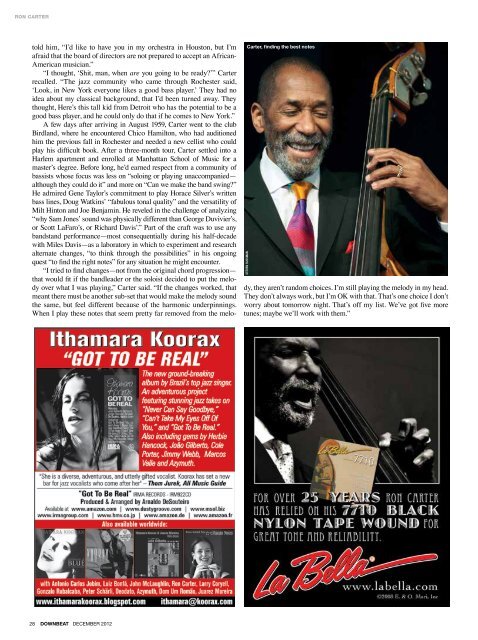Ron Carter Esperanza Spalding - Downbeat
Ron Carter Esperanza Spalding - Downbeat
Ron Carter Esperanza Spalding - Downbeat
Create successful ePaper yourself
Turn your PDF publications into a flip-book with our unique Google optimized e-Paper software.
RON CARTER<br />
Steven sussman<br />
<strong>Carter</strong>, finding the best notes<br />
told him, “I’d like to have you in my orchestra in Houston, but I’m<br />
afraid that the board of directors are not prepared to accept an African-<br />
American musician.”<br />
“I thought, ‘Shit, man, when are you going to be ready?’” <strong>Carter</strong><br />
recalled. “The jazz community who came through Rochester said,<br />
‘Look, in New York everyone likes a good bass player.’ They had no<br />
idea about my classical background, that I’d been turned away. They<br />
thought, Here’s this tall kid from Detroit who has the potential to be a<br />
good bass player, and he could only do that if he comes to New York.”<br />
A few days after arriving in August 1959, <strong>Carter</strong> went to the club<br />
Birdland, where he encountered Chico Hamilton, who had auditioned<br />
him the previous fall in Rochester and needed a new cellist who could<br />
play his difficult book. After a three-month tour, <strong>Carter</strong> settled into a<br />
Harlem apartment and enrolled at Manhattan School of Music for a<br />
master’s degree. Before long, he’d earned respect from a community of<br />
bassists whose focus was less on “soloing or playing unaccompanied—<br />
although they could do it” and more on “Can we make the band swing?”<br />
He admired Gene Taylor’s commitment to play Horace Silver’s written<br />
bass lines, Doug Watkins’ “fabulous tonal quality” and the versatility of<br />
Milt Hinton and Joe Benjamin. He reveled in the challenge of analyzing<br />
“why Sam Jones’ sound was physically different than George Duvivier’s,<br />
or Scott LaFaro’s, or Richard Davis’.” Part of the craft was to use any<br />
bandstand performance—most consequentially during his half-decade<br />
with Miles Davis—as a laboratory in which to experiment and research<br />
alternate changes, “to think through the possibilities” in his ongoing<br />
quest “to find the right notes” for any situation he might encounter.<br />
“I tried to find changes—not from the original chord progression—<br />
that would fit if the bandleader or the soloist decided to put the melody<br />
over what I was playing,” <strong>Carter</strong> said. “If the changes worked, that<br />
meant there must be another sub-set that would make the melody sound<br />
the same, but feel different because of the harmonic underpinnings.<br />
When I play these notes that seem pretty far removed from the melody,<br />
they aren’t random choices. I’m still playing the melody in my head.<br />
They don’t always work, but I’m OK with that. That’s one choice I don’t<br />
worry about tomorrow night. That’s off my list. We’ve got five more<br />
tunes; maybe we’ll work with them.”<br />
28 DOWNBEAT DECEMBER 2012
















